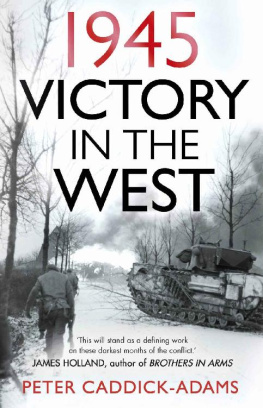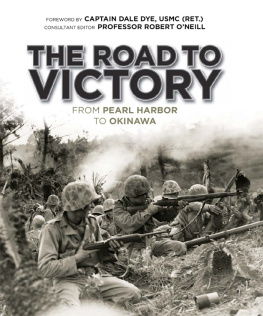Wrinn - Operation Iceberg: 1945 Victory on Okinawa
Here you can read online Wrinn - Operation Iceberg: 1945 Victory on Okinawa full text of the book (entire story) in english for free. Download pdf and epub, get meaning, cover and reviews about this ebook. year: 2021, publisher: Storyteller Books, LLC, genre: History. Description of the work, (preface) as well as reviews are available. Best literature library LitArk.com created for fans of good reading and offers a wide selection of genres:
Romance novel
Science fiction
Adventure
Detective
Science
History
Home and family
Prose
Art
Politics
Computer
Non-fiction
Religion
Business
Children
Humor
Choose a favorite category and find really read worthwhile books. Enjoy immersion in the world of imagination, feel the emotions of the characters or learn something new for yourself, make an fascinating discovery.
Operation Iceberg: 1945 Victory on Okinawa: summary, description and annotation
We offer to read an annotation, description, summary or preface (depends on what the author of the book "Operation Iceberg: 1945 Victory on Okinawa" wrote himself). If you haven't found the necessary information about the book — write in the comments, we will try to find it.
Wrinn: author's other books
Who wrote Operation Iceberg: 1945 Victory on Okinawa? Find out the surname, the name of the author of the book and a list of all author's works by series.
Operation Iceberg: 1945 Victory on Okinawa — read online for free the complete book (whole text) full work
Below is the text of the book, divided by pages. System saving the place of the last page read, allows you to conveniently read the book "Operation Iceberg: 1945 Victory on Okinawa" online for free, without having to search again every time where you left off. Put a bookmark, and you can go to the page where you finished reading at any time.
Font size:
Interval:
Bookmark:

Never miss a new release by signing up for my free readers group. Youll also get WW2: Spies, Snipers and Tales of the World at War delivered to your inbox. (You can unsubscribe at any time.) Tap here to sign up

At dawn on May 29, 1945, the 1st Marine Division began their fifth consecutive week of frontal assaults. This was part of the Tenth Armys relentless offensive against Japanese defenses in southern Okinawa.
Operation Icebergs mission to secure Okinawa was now two months old and badly bogged down. The fast-paced opening had been replaced by weeks of exhausting and bloody attrition warfare against the Shuri Castle.
The 1st Division were hemmed in between two other divisions. They had precious little room to maneuver and had advanced less than a thousand yards in eighteen days. An average of fifty-five murderous yards per day. Their sector was one bristling, honeycombed ridgeline after anotherKakazu, Dakeshi, and Wana.
But just beyond was the long shoulder of Shuri Ridge. Nerve center of the Imperial Japanese Thirty-second Army. The outpost of dozens of forward artillery observers, whod made life miserable for the Allied landing force. On this wet, rainy, and cold morning, things were different. It was quieter. After days of savage and bitter fighting, Allied forces overran Conical Hill to the east and Sugar Loaf to the west. Shuri Castle no longer seemed invincible.
The 1/5 Marines moved out cautiously and expected the usual firestorm of enemy artillery at any moment. But there was none. Marines reached the crest of Shuri Ridge without a fight. Amazed, the company commander looked west along the road toward the ruins of Shuri Castle: a medieval fortress of ancient Ryukyuan kings.
Soldiers in the Tenth Army expected the Japanese to defend Shuri to the death, but the place seemed lightly held. Spiteful small arms fire came from nothing more than a rearguard. Field radios buzzed with this surprising news. Shuri Castle laid in the distance, ready for the taking. Marines asked for permission to seize their long-awaited prize.
General Pedro del Valle, CO of the 1st Marine Division, didnt hesitate. According to corps division boundaries, Shuri Castle belonged to soldiers of the 77th Infantry Division. General del Valle knew his counterpart, Army General Andrew Bruce, would be furious if the Marines snatched their long-sought trophy before his soldiers could arrive. This was a unique opportunity to grab the Tenth Armys primary objective. General del Valle gave the go-ahead, and with that, the 1/5 Marines raced along the west ridge against light opposition and secured Shuri Castle.
After General del Valles staff did some fancy footwork to keep peace with their army neighbors, they learned the 77th had scheduled a massive castle bombardment that morning. Frantic radio calls averted the near-catastrophe just in time. General Bruce was infuriated by the Marines unauthorized initiative. Del Valle later wrote: I dont think a single Army commander would talk to me after that.
Through the inter-service aggravation, Allied forces had achieved much this morning. For two months, Shuri Castle had provided the Japanese with a superb field of observed firecovering southern Okinawa's entire five-mile neck. But as the 1/5 Marines deployed into a defensive line within the castles rubble, they were unaware that a Japanese rearguard still occupied a massive subterranean headquarters underneath them. Marines soon discovered that directly under their muddy boondockers was the underground headquarters of the Japanese Thirty-second Army. This mammoth complex was over 1,200 feet long and 160 feet deep: all dug by pick and shovel.
The enemy had stolen a march on the approaching Tenth Army. Japanese forces retreated south during the rains and occupied the third (final) ring of their prepared underground defenses: a series of fortified escarpments on the Kiyamu Peninsula.
Seizing Shuri Castle was an indisputable milestone in the Okinawa campaign. Still, it was a hollow victory. Like the flag-raising on Iwo Jimas Suribachi signified the end of the beginning of that prolonged battle. The capture of Shuri Castle did not end the fighting. The savage slugfest on Okinawa continued for another twenty-four dayswhile the plum rains fell and the horrors and dying on both sides continued.

The battle of Okinawa covered a seven-hundred-mile arc from Kyushu to Formosa. It involved a million combatantsJapanese, Americans, British, and Okinawan natives. This battle rivaled the Normandy invasion because it was the biggest and bloodiest operation of the Pacific War. In eighty-two days of combat, Allied forces and unfortunate noncombatants suffered an average of 3,000 lives lost a day.
By the spring of 1945, the Empire of Japan was a wounded wild animal: desperate, cornered, and furious. Japanese leaders knew Okinawa under Allied control would be transformed into the England of the Pacific. It would serve as a staging point for the invasion of the sacred homeland. The Japanese would sacrifice everything to avoid the unspeakable disgrace of unconditional surrender and foreign occupation.
The US Navy was presented with its greatest operational challenge to date: how to protect a gigantic and exposed amphibious task force tethered to the beachhead against Japanese kamikaze attacks. Okinawa would be the ultimate test of US amphibious power and projection. Could Allied forces in the Pacific Theater plan and execute such a massive assault against a heavily defended landmass? Could the Allies integrate the tactical capabilities of all the services and fend off every imaginable form of counterattack while maintaining operational momentum?
Operation Iceberg was not executed in a vacuum. Preparatory action to the invasion kicked off at the same time campaigns on Iwo Jima and the Philippines were still being wrapped upanother strain on Allied resources. But as dramatic and sprawling as the battle of Okinawa proved to be, both sides saw this contest as an example of the even more desperate fighting soon to come with the invasion of the Japanese home islands. The closeness of Okinawa to Japan was well within medium bomber and fighter escort range. Its valuable military ports, anchorages, airfields, and training areas made this skinny island imperative for Allied forceseclipsing their earlier plans for the seizure of Formosa.
Okinawa is the largest of the Ryukyuan Islands. The island sits at the apex of a triangle nearly equidistant to strategic areas. Formosa is 330 miles to the southwest, Kyushu is 350 miles to the north, while Shanghai is 450 miles to the west. As on so many Pacific battlefields, Okinawa had a peaceful heritage. Officially an administrative prefecture of Japan (forcibly seized in 1879), Okinawans were proud of their long Chinese legacy and unique sense of community.
Imperial headquarters in Tokyo did little to garrison or fortify Okinawa at the beginning of the Pacific War. After the Allies conquered Saipan, Japanese headquarters sent reinforcements and fortification materials to critical areas within the Inner Strategic Zone, Peleliu, the Philippines, Iwo Jima, and Okinawa.
Font size:
Interval:
Bookmark:
Similar books «Operation Iceberg: 1945 Victory on Okinawa»
Look at similar books to Operation Iceberg: 1945 Victory on Okinawa. We have selected literature similar in name and meaning in the hope of providing readers with more options to find new, interesting, not yet read works.
Discussion, reviews of the book Operation Iceberg: 1945 Victory on Okinawa and just readers' own opinions. Leave your comments, write what you think about the work, its meaning or the main characters. Specify what exactly you liked and what you didn't like, and why you think so.














